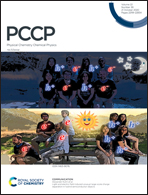Geometric and electronic structure analysis of calcium water complexes with one and two solvation shells†
Abstract
Neutral and cationic calcium water complexes are studied by means of high-level quantum calculations. Both the geometric and electronic structure of these species is investigated. We study complexes with up to eight water molecules in the first solvation sphere of calcium Ca(H2O)n=1–80,+, and examine their stability with respect to Ca(H2O)n–k@kH2O0,+, where a number k of water molecules resides at the second solvation shell. For the cationic species, we find that five water molecules readily attach to calcium and the sixth water molecule goes to the second shell. The hexa-coordinated calcium core is restored after the addition of a seventh water molecule. For neutral species, zero-point energy corrections are critical in stabilizing structures with water ligands directly bound to calcium for up to six water ligands. The (one or two) valence electrons of Ca+ and Ca are displaced gradually from the valence space of calcium to the periphery of the complex forming solvated electron precursors (SEPs). For example, in the ground state of Ca(H2O)6+ one electron occupies an s-type diffuse peripheral orbital, which can be promoted to higher energy p-, d-, f-, g-atomic-type orbitals (1s, 1p, 1d, 2s, 1f, 2p, 2d, 1g, 3s) in the excited states of the system. Finally, we considered the effect of a complete second solvation shell using the Ca(H2O)6+@12H2O cluster, which is shown to have significantly lower excitation energies compared to the Ca(H2O)6+.



 Please wait while we load your content...
Please wait while we load your content...